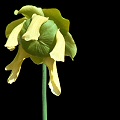
Former Florida habitat
Conservation and Carnivorous Plants
Carnivorous plants, like amphibians, are sentinels of the general quality of
our environment. One of the first things to disappear when a wetland habitat degrades
is its carnivorous plants. More than 95% of the carnivorous plant habitat
in the USA alone has been destroyed. Every year, I hear of many places where
carnivorous plants once lived but is now only a grocery store, parking lot, or
mowed field. Compared to 50 years ago, we have nearly lost all our carnivorous plant
heritage. The crumbs that are left are pathetic. And in another 50 years, will there
be anything at all left?
You do not have to be a devoted conservationist to be concerned about carnivorous
plants in the wild. Many hobbyists who might not consider themselves
particularly "green" find that their interest in carnivorous plants
inevitably leads them to concern about wild habitats. I think this is because
carnivorous plants are not very domesticated.
Ask gardeners where their tomato plants are native to (South America, by the way),
and they will reward you with blank looks. In contrast, most carnivorous
plant growers will be able to tell you the country, and perhaps even state or
province their plants originated (even if their plants have been in cultivation
for many decades). Awareness of the plants in the wild seems to lead to
an interest in the conservation status of the wild plants.
For me, the progression towards being a diehard conservationist went as follows. But my story is not unique!

Sarracenia flava
- Originally I only grew carnivorous plants. All else was eschewed. (For some others, there are often related interests in other specialty topics, such as lizards or cacti, but that is for another FAQ.)
- I became interested in other wetland plants, particularly bog orchids. I started dreaming about visiting carnivorous plant habitats.
- The trips began. Snakes, quaking Sphagnum mats, mosquitoes, suspicious locals, and incredulous stares from astonished mates were all endured so I could locate plants in the wild. Poison ivy, ticks, thorns and fangs were irrelevant when the hunt was on.
- Occasionally I followed directions to an "incredible site", only to find a new housing development or shopping mall. Tears fell.
- Eventually, I was transformed into something of a naturalist, with a passionate love for wetlands, carnivorous plants in general, and an overall concern for the environment.
- In an excessive act, I changed professions to work for a conservation nonprofit (The Nature Conservancy). Even more, I volunteer for other conservation nonprofits such as the International Carnivorous Plant Society.
It is natural that there is a large cross-over between the carnivorous plant enthusiast and an interest in conservation.
- Why do most carnivorous plants live in wetlands?
- Why are these wetlands nutrient poor?
- How can carnivorous plant habitat be destroyed?
- Pond, bog, swamp, marsh, fen---what are the differences?
- How are carnivorous plants doing in the wild?
- Are wildfires good for habitat?
- What are invasive species, and why are they bad?
- Where can I see wild carnivorous plants?
- May I collect carnivorous plants from the wild?
- Why can't I collect plants if the land they live on is being destroyed anyway?
- What about field collecting Endangered Sarracenia?
- What about field collecting endangered Sarracenia?
- What are the restrictions from the Endangered Species Act?
- What are ICPS Location Codes and how do they relate to conservation?
- What is CITES?
- What carnivorous plants are covered by CITES?
- What are the really rare carnivorous plants?
- Should I plant carnivorous plants in habitats they don't live in already?
- Is it OK to plant carnivorous plants along roadsides?
- Are any carnivorous plants "noxious"?
- I saw pitchers in a flower arrangement. Is this bad?
- Where do plants being sold in stores come from?
- What is all this about "anthocyanin-free plants"?
- What is this controversy I hear about Sphagnum and peat bogs?
- How can I help save carnivorous plants from extinction?
- Ending Comments: Carnivorous Plants and Conservation